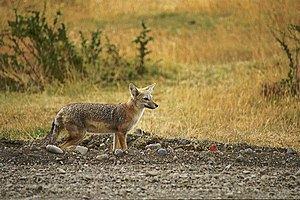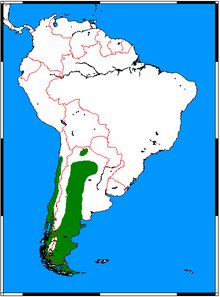Argentine battle fox
| Argentine battle fox | ||||||||||||
|---|---|---|---|---|---|---|---|---|---|---|---|---|

Argentine fox ( Lycalopex griseus ) |
||||||||||||
| Systematics | ||||||||||||
|
||||||||||||
| Scientific name | ||||||||||||
| Lycalopex griseus | ||||||||||||
| ( Gray , 1837) |
The Argentine fighting fox ( Lycalopex griseus , syn .: Pseudalopex griseus ), also called Patagonian fox, gray Andean fox or chilla , occurs in the plains of the pampas , in some deserts and low mountains in South America . He belongs to the real dogs .
Taxonomy
The Argentine fighting fox is carried with five other species in the genus Lycalopex . The relationships within the genus and to other South American wild dogs have not yet been fully explored. In the past z. B. the Darwin fox ( Lycalopex fulvipes ) regarded as a subspecies or island population of the Argentine fighting fox. Individual genetic studies suggest that the species is identical to the pampas fox ( Lycalopex gymnocercus ).
The various publications differentiate between zero and up to four subspecies:
- Lgmaullinicus Northern Chile (I to IX region)
- Lgdomeykoanus Argentina and Chile (VIII to XI region)
- Lggriseus southwestern distribution area in Argentina
- Lggracillis montes desert in Argentina.
Hybridization in the overlapping areas is quite common.
features
Adults reach a head-trunk length of 50 to 66 cm, to which a 12 to 35 cm long tail comes. The weight varies between 2.5 and 4.0 kg. In its external appearance, the species is similar to the actual foxes ( Vulpes ), but is noticeable for its surprisingly large, 7.5 to 8.0 cm long ears. The fur color varies between light gray and light brown, with the underside being lighter. The tooth formula is 3 / 3-1 / 1-4 / 4-2 / 3 = 42
distribution
The Argentine fox is widespread on both sides of the Andes in Chile and Argentina , reports of occurrence in Peru are considered uncertain. In the north it reaches about 17 ° south latitude. The climatic conditions in the distribution area are very different, as is the case in the Atacama Desert of Chile, with less than 2 mm of rain per year and an average annual temperature of 22 ° C, but also in moist, southern rainforests with 2000 mm of rainfall (average annual temperature 12 ° C C) but also in open, dry landscapes such as steppes, pampas and not too dry bushland ( Matorral ), but also occurs in forests and on Tierra del Fuego, where the mean annual temperature is around 7 ° C. It is often found at lower altitudes than the Andean jackal ( Lycalopex culpaeus ). However, specimens have already been spotted at an altitude of 4,000 meters.
The Argentine battle scarf was introduced specifically in some regions of South America. So in 1951 he was released in Tierra del Fuego in order to master the rabbit plague there. The introduction of this species, however, had a negative effect on the red-headed goose population . This species, which belongs to the demi-geese, is the rarest of the mirror geese . The decline in the population is attributed, among other things, to the spread of the Argentine battle fox.
Way of life
This wild dog feeds on smaller mammals, birds, insects and reptiles, which it surprises on the ground. It also eats fruit and carcasses and occasionally rips lambs. Among the fruits, the species Prosopanche americana , Cryptocarya alba and Lithraea caustica are increasingly found as food sources. The behavior when looking for food depends on the prey or the type of plant. The animals mostly hunt alone, but occasionally 4 to 5 specimens have been seen hunting together. This was probably a couple of parents with the almost fully grown offspring. The hunt mostly takes place at night, but when most of the prey is active during the day, the Argentine battle fox can adapt.
Reproduction
It is assumed that both sexes become sexually mature at around one year of age. Males and females usually form monogamous pairs who rarely meet outside of the mating season. Sometimes another female helps with the rearing of the young and rarely does one male mate with two females. Usually the pairs have territories of 0.2 to 2.9 km² that are defended against other conspecifics.
Mating generally takes place in August and September. After a gestation of 53 to 58 days, four to six young are born in October. The birth takes place in a shelter that is not dug itself, but a natural cavity or a man-made facility, such as a passage under a path. For the first three to four days after birth, the female stays in the burrow and receives food from the male. After that, the young animals are looked after equally by both sexes. After about a month the offspring go on short trips and after five to six months the parents leave. Sexual maturity presumably occurs after a year, but this value is not certain.
Argentine fighting foxes actually have no natural enemies; only in isolated cases have specimens of pumas and Andean jackals been killed.
The average age in nature is unknown, animals in the zoo of Santiago de Chile ( Zoológico Nacional de Chile ) were around five years old.
Argentine battle fox and people
Since this wild dog is viewed by farmers as a predator of smaller pets, it is shot or trapped. There was extensive hunting for the fur animal until the 1980s . Older reports mention 700,000 to 1,200,000 battle fox skins that were sold for about $ 39 each between 1976 and 1979. However, it is unclear whether this information was exaggerated or whether other South American wild dogs were also included. By 1986 exports sank to around 100,000 to 300,000 skins per year, most of which came to Germany. Around 1990 exports were around 33,000 skins. After that there was again a slight increase due to increased demand from Russia. It is also true for the last values that they partially affect other species of the genus Lycalopex .
The IUCN regards the total population of the species as stable and lists the Argentine fighting fox, also because of its large distribution area, as "not endangered" ( Least Concern ). However, it is legally protected in the Argentine provinces of Mendoza, Entre Rios, Catamarca and San Luis, as well as the stocks in Chile, with the exception of Tierra del Fuego .
Individual evidence
- ^ A b Wilson & Reeder (eds.): Mammal Species of the World . 3. Edition. Johns Hopkins University Press, Baltimore 2005, ISBN 0-8018-8221-4 , Lycalopex (English, online ).
- ↑ a b c d e f g h Claudio Sillero-Zubiri, Michael Hoffmann, David Whyte Macdonald: Canids: Foxes, Wolves, Jackals and Dogs. (PDF; 9.9 MB) IUCN , 2004, pp. 56-63 , accessed on January 24, 2012 .
- ↑ a b c d e Mauro Lucherini: Wild dogs . Ed .: Udo Gansloßer, Claudio Silleo-Zubiri. tape . Filander Verlag, 2006, ISBN 3-930831-63-5 , Grauer Andenfuchs or Chilla, p. 155 ff .
- ↑ a b c Lycalopex griseus in the endangered Red List species the IUCN 2011. Posted by: Jiménez et al , 2008. Accessed January 28, 2012 Design.
- ↑ Janet Kear (Ed.): Ducks, Geese and Swans . Oxford University Press, 2005, ISBN 0-19-854645-9 , p. 419
literature
- Helmut Lingen: Large lexicon of animals . Lingen, Cologne 1989.

